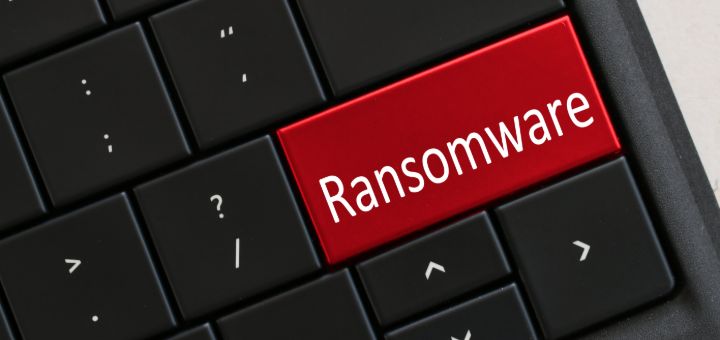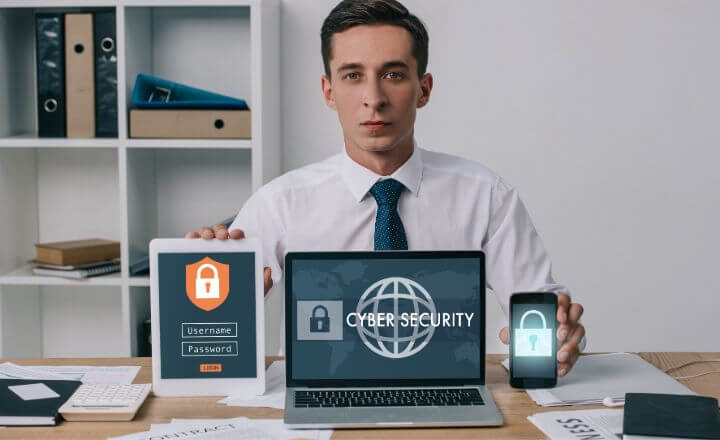(Updated on January 9th, 2023)
Cybersecurity is becoming more and more important as our world becomes increasingly digital and cybercriminals find ways of subverting basic cybersecurity measures. Here are some of the most effective advanced cybersecurity options for the future to help protect your business.
- 1. Identity and Access Management
- 2. Blockchain
- 3. Artificial Intelligence and Machine Learning
- 4. Virtualization
- 5. Automation
- 6. Containerization
- 7. Data Encryption
- 8. Breach Detection
- 9. Disaster Recovery
- 10. Employee Training
- 11. Penetration Testing
- 12. Personnel Screening
- 13. Physical Security
- 14. Secure Coding
- 15. Secure Development
- 16. Network Segmentation
- 17. BYOD Policy
- 18. Implementation of Dmarc
- 19. Use of a Proxy Server
- Conclusion
1. Identity and Access Management
Identity and access management (IAM) is a security measure that allows businesses to control who has access to their data and systems. IAM can help to prevent unauthorized access and ensure that only authorized users can access sensitive data, especially if you are using more advanced certificate authentication.
IAM is becoming increasingly important as more and more businesses move to the cloud. With IAM, businesses can rest assured that their data is safe and only accessible by authorized users. One way that IAM is being used is through multi-factor authentication, which requires multiple forms of identification before access is granted.
2. Blockchain
Although blockchain is most commonly known as the technology behind Bitcoin and other cryptocurrencies, it has a lot of potential for businesses as well. Blockchain is essentially a distributed database that allows for secure, transparent, and tamper-proof transactions. This could be extremely valuable for businesses that need to keep track of their transactions and data securely.
Blockchain will play an important role in cybersecurity moving forward, as it can help to secure data and transactions while also providing transparency.
3. Artificial Intelligence and Machine Learning
Artificial intelligence (AI) and machine learning are two technologies that are quickly gaining traction in the cybersecurity world. AI can be used to detect and respond to threats in real-time, while machine learning can be used to analyze data and identify patterns.

Both of these technologies have a lot of potential for businesses, as they can help to improve security while also reducing the amount of manual work that needs to be done. For example, AI can be used to monitor suspicious activity, while machine learning can be used to identify new threats.
4. Virtualization
Virtualization is a technology that allows businesses to create virtual copies of their physical servers. This can be helpful for businesses that need to run multiple operating systems or applications on a single server. One way that virtualization can be used for cybersecurity is by creating virtual machines that are isolated from the rest of the network. This can help to prevent malware from spreading to other systems.
Once a virtual machine is infected, it can be discarded without affecting the rest of the network, making it a valuable tool for businesses that are concerned about cybersecurity.
5. Automation
Automation is a technology that allows businesses to automate certain tasks, such as the deployment of software or the configuration of systems. Automation can be helpful for businesses that need to make changes to their systems on a regular basis.
An example of how automation can be used for cybersecurity is by automating the deployment of security updates. This can help to ensure that systems are always up-to-date and secure, making it easier to respond to new threats. Instead of having to manually update each system, updates can be automatically deployed using automation.
6. Containerization
Containerization is a technology that allows businesses to package their applications and data into self-contained units. This can be helpful for businesses that need to deploy multiple applications on a single server. If one application is compromised, the other applications on the server are not affected.
Containerization can also be used to improve security. By separating applications and data into separate containers, businesses can make it harder for malware to spread from one application to another. Containerization is an important technology that businesses should consider using in order to improve their cybersecurity.
7. Data Encryption
Data encryption is a process of encoding data so that it can only be accessed by authorized users. Encryption can help to protect data from being accessed by unauthorized users, such as hackers.
One way that businesses can use data encryption is by encrypting their backups. This can help to ensure that if their data is stolen, it cannot be accessed by the thieves. Data encryption can also be used to protect sensitive data, such as credit card numbers. There are plenty of encryption options available, so businesses should research the best option for their needs and budget.
8. Breach Detection
Breach detection is a process of identifying and responding to a security breach. A breach can be the result of a hacker attacking your system, or it can be the result of an employee accidentally leaking sensitive data. When a breach is detected, it is important to take immediate action in order to minimize the damage.
There are many breach detection tools available, such as intrusion detection systems and data loss prevention systems. These tools can help businesses to identify and respond to a security breach quickly by monitoring for suspicious activity.
9. Disaster Recovery
Disaster recovery is the process of recovering from a natural or man-made disaster. A disaster can be anything from a hurricane to a data breach. When a disaster occurs, it is important to have a plan in place for recovering your systems and data.
There are many different types of disaster recovery plans, such as the cloud, tape backups, and replication. Disaster recovery can mean the difference between a business surviving or failing after a disaster.
10. Employee Training
Employee training is one of the most important steps businesses can take to improve their cybersecurity. Employees need to be trained on how to recognize a phishing attack, how to protect their passwords, and how to respond to a security breach. When employees are empowered to take action, it can help to prevent or minimize the damage from a security breach.

There are many different employee training programs available, so businesses should research the best option for their needs. Employee training is an important part of any cybersecurity plan and should not be overlooked, especially given that employees tend to represent a business’ biggest cyber vulnerability and threat.
11. Penetration Testing
Penetration testing is a process of testing your system for vulnerabilities. Penetration testers attempt to exploit vulnerabilities in order to gain access to your systems. This can help businesses to find and fix vulnerabilities before they are exploited by hackers.
There are many different types of penetration testing, such as black-box testing and white box testing. Businesses should consider using a penetration tester to help them find and fix vulnerabilities in their systems. An example of how penetration testing can preempt cybersecurity disaster is the now-infamous story of the Target breach.
Because Target had their systems penetrated and tested by a third party, they were able to identify and fix the vulnerability that was later exploited by the hackers.
12. Personnel Screening
Personnel screening is the process of vetting employees before they are hired. This can include checking their references, conducting background checks, and verifying their identity.
Vetting employees is important because it can help to prevent Insider Threats. An Insider Threat is an employee who deliberately or accidentally leaks sensitive data. By screening employees before they are hired, businesses can help to reduce the chances of an Insider Threat occurring.
13. Physical Security
Physical security is the process of protecting your premises and data from physical threats. Physical threats can include anything from burglars to natural disasters. When a business has physical security measures in place, it can help to deter or prevent attacks.
There are many different types of physical security, such as CCTV, access control, and fire suppression. Businesses should consider which physical security measures are most appropriate for their needs. Physical security is an important part of any cybersecurity plan and should not be overlooked, especially as more and more IoT technology is incorporated into businesses.
14. Secure Coding
Secure coding is the process of writing code that is secure and resistant to attack. Secure coding can help businesses to protect their systems from hackers and malware. You can employ secure coding by writing code that is resistant to SQL injection attacks, using encryption, and by inputting data validation.
The benefits of secure coding are that it can help businesses to prevent their systems from being hacked. In addition, secure coding can also help businesses to save money, as they will not need to pay for repairs or replacements if their system is hacked.
15. Secure Development
Secure development is the process of creating and implementing a secure development lifecycle. A secure development lifecycle is a process that helps to ensure that all software is developed securely. By using a secure development lifecycle, businesses can help to protect their systems from hackers and malware.
There are many different components of a secure development lifecycle, such as requirements gathering, design, testing, and deployment. Businesses should consider using a secure development lifecycle to help them protect their systems.
16. Network Segmentation
Network segmentation is a technique that allows businesses to break their network into smaller segments. This can help to improve security by making it harder for malware to spread and by making it easier to identify and isolate attacks.
There are many different ways to segment a network, such as virtual LANs, firewalls, and intrusion detection systems. Businesses should consider which method of segmentation is most appropriate for their needs, particularly the size of their network. Network segmentation is an important part of any cybersecurity plan and can help to improve security by making it more difficult for malware to spread.
17. BYOD Policy
BYOD stands for “bring your own device” and refers to the trend of employees bringing their personal devices to work. BYOD policies allow businesses to embrace this trend while still maintaining security. BYOD policies typically require employees to sign a waiver stating that they will comply with the security policies of the company.
BYOD policies can help businesses to improve security by ensuring that all devices used on the network are secure. In addition, BYOD policies can also help businesses to save money, as they will not need to provide devices for their employees.
18. Implementation of Dmarc
DMARC stands for “domain-based message authentication, reporting, and conformance”. DMARC is an email authentication standard that helps businesses to protect their email from being spoofed.

When a business has implemented DMARC, they can help to prevent their email from being used in phishing attacks. In addition, businesses that have implemented DMARC can also help to improve their reputation with email providers. DMARC is an important part of any cybersecurity plan and should be considered by businesses that send or receive an email (i.e., all businesses).
19. Use of a Proxy Server
A proxy server is a device that sits between the client and the server. Proxy servers can help to improve security by filtering out malicious traffic and by caching common requests.
Proxy servers can be used to improve the security of a network in many different ways, such as by filtering traffic, blocking malicious traffic, and caching common requests. Businesses should consider using a proxy server to help them protect their systems from hackers and malware.
Conclusion
In summation, the bare minimum when it comes to cybersecurity is no longer enough. The ever-evolving cybersecurity landscape requires advanced options that businesses should be implementing in order to stay ahead of the curve and protect themselves.
While not all of these options will be applicable to every business, it is important for businesses to evaluate their needs and implement the appropriate solutions. By using a variety of these advanced options, businesses can help to improve their security posture and protect themselves from cyberattacks.







